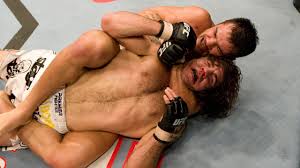Mixed Martial Arts (MMA) has evolved into a dynamic and multifaceted sport, blending various combat disciplines to create a comprehensive fighting system. Among the diverse techniques employed in MMA, submissions play a crucial role in securing victories through joint locks and chokes. As we head into 2024, several submission techniques stand out for their effectiveness and innovation. This article delves into the top MMA submission techniques for 2024, providing insights into their application, benefits, and how they can be integrated into a fighter’s arsenal.
1. The Evolution of Submission Techniques in MMA

MMA has witnessed significant advancements in submission techniques over the years. Fighters now employ a blend of traditional and modern submissions, often integrating elements from Brazilian Jiu-Jitsu (BJJ), catch wrestling, and other grappling arts. The evolution of these techniques reflects the ongoing innovation and strategic thinking in the sport.
1.1. Historical Context
Traditional submissions, such as the armbar and rear-naked choke, have long been staples in MMA. However, the sport’s rapid evolution has led to the development of hybrid techniques and new variations that enhance a fighter’s effectiveness in securing submissions.
1.2. Modern Adaptations
Contemporary MMA fighters continuously adapt and refine submission techniques to address the evolving strategies of their opponents. This includes incorporating elements from other martial arts and developing new approaches to traditional submissions.
2. Top Submission Techniques for 2024
Here are some of the most effective submission techniques making waves in MMA for 2024:
2.1. The Guillotine Choke
The guillotine choke remains one of the most effective submissions in MMA. This technique involves trapping an opponent’s head and arm in a chokehold, leveraging the fighter’s arms and body to apply pressure to the neck.
2.1.1. Execution
- Positioning: Secure a front headlock position by wrapping your arm around your opponent’s neck.
- Grip: Use a palm-to-palm grip or a gable grip to secure the choke.
- Finish: Drop to your back or squeeze while lifting your opponent’s head to apply maximum pressure.
2.1.2. Advantages
- Versatility: Can be applied from various positions, including standing and on the ground.
- Effectiveness: Effective against opponents attempting takedowns or in clinch situations.
2.2. The Kimura Lock
The Kimura lock is a versatile shoulder lock that can be executed from multiple positions, including guard and side control. It targets the shoulder joint and can force an opponent to tap out or submit.
2.2.1. Execution
- Positioning: Secure an underhook and isolate the opponent’s arm.
- Grip: Use a figure-four grip to secure the arm and apply pressure to the shoulder joint.
- Finish: Rotate the opponent’s arm behind their back while maintaining control.
2.2.2. Advantages
- Adaptability: Can be transitioned into from various positions and combined with other submissions.
- Control: Provides significant control over the opponent’s arm and shoulder.
2.3. The Triangle Choke
The triangle choke is a powerful submission that uses the legs to trap the opponent’s head and arm, applying pressure to the neck. This technique is highly effective when executed correctly.
2.3.1. Execution
- Positioning: From the guard position, secure one of your opponent’s arms and use your legs to form a triangle around their neck.
- Grip: Lock the triangle by locking your feet together and using your legs to squeeze.
- Finish: Pull down on the opponent’s head and tighten the triangle to apply maximum pressure.
2.3.2. Advantages
- Efficiency: Can be applied quickly and effectively from the guard position.
- Control: Provides significant control over the opponent’s upper body and head.
2.4. The Armbar
The armbar is a classic submission that targets the elbow joint, forcing an opponent to submit or risk injury. It remains a staple in MMA due to its effectiveness and versatility.
2.4.1. Execution
- Positioning: Isolate the opponent’s arm by securing it between your legs.
- Grip: Use your legs to control the opponent’s arm and apply pressure to the elbow joint.
- Finish: Extend the opponent’s arm while applying pressure to the elbow joint to achieve the submission.
2.4.2. Advantages
- Classic Technique: Proven effectiveness in both training and competition.
- Adaptability: Can be applied from various positions, including mount, guard, and side control.
2.5. The Omoplata
The omoplata is a shoulder lock submission that involves trapping the opponent’s arm with your legs and applying pressure to the shoulder joint. It is a valuable addition to a fighter’s submission repertoire.
2.5.1. Execution
- Positioning: From the guard position, isolate one of your opponent’s arms and use your legs to trap it.
- Grip: Secure the arm and lock it with your legs, applying pressure to the shoulder joint.
- Finish: Roll your opponent onto their shoulder while maintaining control of their arm.
2.5.2. Advantages
- Unorthodox: Can catch opponents off guard due to its less common application.
- Control: Provides excellent control over the opponent’s arm and shoulder.
3. Training Tips for Mastering Submissions
Mastering submission techniques requires dedicated training and practice. Consider these tips to enhance your submission game:
3.1. Focus on Technique
Proper technique is essential for effective submissions. Practice the fundamentals regularly and seek feedback from experienced practitioners to refine your skills.
3.2. Drill with Purpose
Incorporate drilling exercises into your training routine to improve muscle memory and execution. Focus on specific submissions and their transitions to build proficiency.
3.3. Spar with Strategy
Apply submissions during live sparring sessions to test their effectiveness against resisting opponents. Analyze your performance and adjust your techniques as needed.
3.4. Study High-Level Fighters
Observe and analyze the submission techniques used by high-level MMA fighters. Study their approach and adapt their strategies to your training.
3.5. Maintain Flexibility and Conditioning
Incorporate flexibility and conditioning exercises to enhance your ability to execute submissions and prevent injuries. Focus on core strength, flexibility, and overall physical fitness.
4. The Future of Submission Techniques in MMA

As MMA continues to evolve, submission techniques will likely undergo further innovation. Fighters and coaches will develop new approaches and adaptations to stay ahead of the competition. Staying informed about emerging techniques and trends will be essential for maintaining a competitive edge.
5. Conclusion
Mastering effective submissions in MMA requires dedication, practice, and a deep understanding of technique and strategy. By focusing on top submission techniques for 2024, such as the guillotine choke, Kimura lock, triangle choke, armbar, and omoplata, fighters can enhance their submission game and achieve success in the octagon. Incorporate these techniques into your training routine, stay updated on emerging trends, and continually refine your skills to excel in the dynamic world of MMA.



